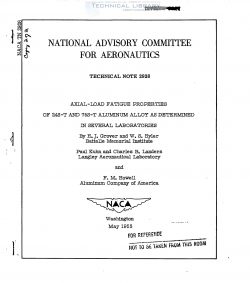naca-tn-2928
- Version
- 137 Downloads
- 2.31 MB File Size
- 1 File Count
- January 20, 2017 Create Date
- January 20, 2017 Last Updated
National Advisory Committee for Aeronautics, Technical Notes - Axial Load Fatigue Properties of 24S-T and 75S-T Aluminum Alloy as Determined in Several Laboratories

In the initial phase of an NACA program on fatigue research, axial-
load tests on 2hS-T3 and 758-T6 aluminum-alloy sheet have been made at
the Battelle Memorial Institute and at the Langley Aeronautical Laboratory
of the National Advisory Committee for Aeronautics. The test specimens
were polished and unnotched. The manufacturer of the material, the
Aluminum Company of America, has made axial-load tests on ans—Tu
and YES-T6 rod material. The test techniques used at the three labora-
tories are described in detail; the test results are presented and are
compared with each other and with results obtained on.unpolished sheet
by the National Bureau of Standards.
Many engineering structures and all machinery are subjected to
repeated loads and are thus potentially liable to minor or major failures
by fatigue. As designs become more refined, fatigue generally changes
first from a minor to a major and costly nuisance and finally may become
a dominant design criterion. This stage has been reached for several
classes of airplanes.
Although fatigue research has been pursued for over a hundred years,
it is not possible at present to design against fatigue failure with
anywhere near the same confidence as against static failure. In order
to improve this situation insofar as possible, the National Advisory
Committee for Aeronautics (NACA) initiated a long-range research program
about l9h7.
This paper gives results obtained in a fundamental phase of the
program, the determination of the fatigue properties of two aluminwm
alloys (2hS-T3 and TSS-T6) widely used for airframe construction. The
main purpose of the tests was to furnish base-line data for succeeding
phases of the program, such as investigations of notch effect and cumu-
lative damage. A large amount of each material_(about“5 tons) was pur-
chased at one time in order to minimize the problem of variation of
material properties in subsequent"phases of the investigation. All the
material was in the form of sheet nominally 0.091 inch thick. The tests
described in this paper were made on unnotched specimens subjected to
axial loading with a constant amplitude of stress at a series of stress
ratios R (ratio of minimum stress to maximum stress in each cycle);
the specimens were electropolished.
| File | Action |
|---|---|
| naca-tn-2928 Axial Load Fatigue Properties of 24S-T and 75S-T Aluminum Alloy as Determined in Several Laboratories.pdf | Download |

Comment On This Post